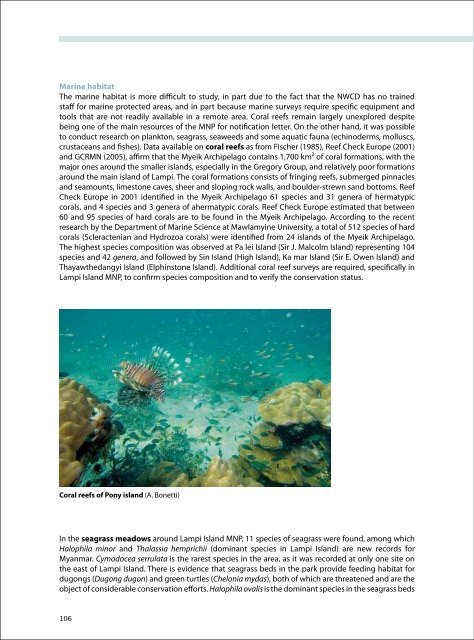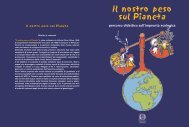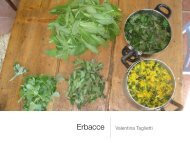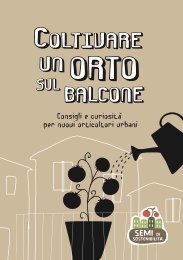Myanmar Protected Areas: Context, Current Status ... - Istituto Oikos
Myanmar Protected Areas: Context, Current Status ... - Istituto Oikos
Myanmar Protected Areas: Context, Current Status ... - Istituto Oikos
You also want an ePaper? Increase the reach of your titles
YUMPU automatically turns print PDFs into web optimized ePapers that Google loves.
Marine habitat<br />
The marine habitat is more difficult to study, in part due to the fact that the NWCD has no trained<br />
staff for marine protected areas, and in part because marine surveys require specific equipment and<br />
tools that are not readily available in a remote area. Coral reefs remain largely unexplored despite<br />
being one of the main resources of the MNP for notification letter. On the other hand, it was possible<br />
to conduct research on plankton, seagrass, seaweeds and some aquatic fauna (echinoderms, molluscs,<br />
crustaceans and fishes). Data available on coral reefs as from Fischer (1985), Reef Check Europe (2001)<br />
and GCRMN (2005), affirm that the Myeik Archipelago contains 1,700 km² of coral formations, with the<br />
major ones around the smaller islands, especially in the Gregory Group, and relatively poor formations<br />
around the main island of Lampi. The coral formations consists of fringing reefs, submerged pinnacles<br />
and seamounts, limestone caves, sheer and sloping rock walls, and boulder-strewn sand bottoms. Reef<br />
Check Europe in 2001 identified in the Myeik Archipelago 61 species and 31 genera of hermatypic<br />
corals, and 4 species and 3 genera of ahermatypic corals. Reef Check Europe estimated that between<br />
60 and 95 species of hard corals are to be found in the Myeik Archipelago. According to the recent<br />
research by the Department of Marine Science at Mawlamyine University, a total of 512 species of hard<br />
corals (Scleractenian and Hydrozoa corals) were identified from 24 islands of the Myeik Archipelago.<br />
The highest species composition was observed at Pa lei Island (Sir J. Malcolm Island) representing 104<br />
species and 42 genera, and followed by Sin Island (High Island), Ka mar Island (Sir E. Owen Island) and<br />
Thayawthedangyi Island (Elphinstone Island). Additional coral reef surveys are required, specifically in<br />
Lampi Island MNP, to confirm species composition and to verify the conservation status.<br />
Coral reefs of Pony island (A. Bonetti)<br />
In the seagrass meadows around Lampi Island MNP, 11 species of seagrass were found, among which<br />
Halophila minor and Thalassia hemprichii (dominant species in Lampi Island) are new records for<br />
<strong>Myanmar</strong>. Cymodocea serrulata is the rarest species in the area, as it was recorded at only one site on<br />
the east of Lampi Island. There is evidence that seagrass beds in the park provide feeding habitat for<br />
dugongs (Dugong dugon) and green turtles (Chelonia mydas), both of which are threatened and are the<br />
object of considerable conservation efforts. Halophila ovalis is the dominant species in the seagrass beds<br />
In-depth Study of Lampi Island Marine National Park<br />
grazed by dugongs. The number, size and species composition of the meadows observed in the Lampi<br />
Island MNP suggest that there is enough seagrass in the area to support a small population of dugongs.<br />
The plankton survey of March 2010 recorded 136 species of phytoplankton belonging to 49 genera<br />
and 150 species of zooplankton belonging to 93 genera were observed. Eight species of plankton are<br />
identified as new records for <strong>Myanmar</strong>: one phytoplankton species, the pinnate diatom Pleurosigma<br />
nicobaricum, and seven zooplankton species, namely: Pegantha sp. (Hydromedusa), Pelagia noctiluca<br />
(Jelly fish), Pleurobranchia rhodopis (Ctenophore) Phtisica marina (Amphipod), Thallassomysis sewelli<br />
(Mysid), Salpa maxima (Salp), Iasis zonaria (Salp). The seaweed surveys recorded 73 species belonging to<br />
46 genus, belonging to blue-green algae Cyanophyta (2 species), green algae Chlorophyta (24 species),<br />
brown algae Phaeophyta (9 species) and red algae Rhodophyta (38). Some important economically,<br />
industrially and medicinally seaweed species were observed. Some green algae, such as Catenella,<br />
Caulerpa and Ulva can be used for the production of health foods and sea vegetables. Catenella which is<br />
known as “Kyauk Pwint” in <strong>Myanmar</strong>, is a famous seafood item and it is also used as food and medicine<br />
to cure or prevent gout. Certain species of brown algae, for example, Dicthyota, Padina, Turbinaria and<br />
Sargassum, could be utilized for the production of alginates, manitol and iodine. Certain species of red<br />
algae, such as Gracilaria could be used for the production of agar-agar while species of Catenella, Hypnea<br />
and Acanthophora are harvested for the production of carrageenan compounds.<br />
Fauna<br />
The project identified 32 species of sea cucumbers, 17 of these were found in the catches of fishermen of<br />
Lampi Island MNP. The diverse sea cucumber fauna supports a small-scale industry that is an important<br />
source of income for local fishers. Interviews with local fishers of sea-cucumbers and dry fish revealed<br />
that the sea-cucumber market is a very profitable one, both for the local and for the foreign market, with<br />
prices ranging from 9 euros/kg for species like Holothuria atra up to more than 30 euros/kg for species<br />
like the sandfish Holothuria scabra, one of the most valuable species. The uncontrolled fishing of sea<br />
cucumber inside the park is arguably leading to over-exploitation, as is the case with other sea cucumber<br />
fisheries in the region. However, the existence of some apparently healthy stocks in some bays of Lampi<br />
Island provides an opportunity to conserve this important fishery through proper management. The<br />
survey of molluscs fauna revealed in the water surrounding the MNP, both within and outside the two<br />
miles of protection, 50 gastropod species belonging to 27 families and 41 bivalve species belonging<br />
to 18 families. Among the Gastropods found in Lampi Island MNP, many species are of economic<br />
importance as food resource and for traditional decoration and shell jewellery: i) Trochus niloticus is the<br />
most economically important shell, collected for commercial use by local divers; ii) Strombus canarium<br />
(Strombidae), very common and abundant in mud, muddy sand habitat and algae bottom of south and<br />
southeast part of Lampi, is collected for food and traditional decoration, for both local use and export<br />
to neighbouring countries; iii) Cerithidea cingulata (Potamidae), a shell traditionally used for decoration<br />
in other coastal areas of <strong>Myanmar</strong> but not in Lampi Island MNP, is abundant in muddy sand, muddy rock<br />
and mangrove fringe habitats; iv) Babylonia areolata (Buccinidae), harvested on sand and mud grounds<br />
near Ko Phawt Island, for food and traditional decoration, both for local use and for export to Thailand; v)<br />
Turbo marmoratus is collected for export to Thailand as a food resource and for shell jewellery. Most of<br />
the species of Family Cypraeidae, generally known as “Kywe poke kha yu”, are very common and inhabit<br />
reef areas and sandy habitats among rock environments, tidal pools, branch corals and seaweed of the<br />
intertidal and sublittoral zone. Almost all species are collected for the food and shell market. The most<br />
famous is Cypraea tigris (tiger cowrie), collected for its shell. Only one individual of this species was found<br />
in Lampi Island MNP, suggesting the need for further investigation. Among the Bivalves found in Lampi<br />
Island MNP, the species of economic importance are: i) pearl oyster Pinctada margaritifera found on hard<br />
substrate in clear water along the coast of Lampi Island and several nearby islands north of Lampi Island;<br />
ii) three species of hammer oyster (Malleidae), Malleus malleus, Malleus albus, Malleus regula, abundant<br />
in rocky and coral reef habitats around the Island, are used by Moken people as traditional food; iii)<br />
edible Polymesoda bangalensis found in brackish water in mangrove swamps area of Crocodile River<br />
bank. Giant clams (Tridacna spp.), collected for their flesh and shell, have also high commercial value<br />
both for the export market and for local trade.<br />
106 107






